
About UsThe Numismatic Bibliomania Society is a non-profit organization promoting numismatic literature. For more information please see our web site at coinbooks.org SubscriptionsThose wishing to become new E-Sylum subscribers (or wishing to Unsubscribe) can go to the following web page link MembershipThere is a membership application available on the web site Membership Application To join, print the application and return it with your check to the address printed on the application. Membership is only $15 to addresses in the U.S., $20 for First Class mail, and $25 elsewhere. For those without web access, write to: David M. Sundman, Secretary/TreasurerNumismatic Bibliomania
Society AsylumFor Asylum mailing address changes and other membership questions, contact David at this email address: dsundman@LittletonCoin.com SubmissionsTo submit items for publication in The E-Sylum, just Reply to this message, or write to the Editor at this address: whomren@coinlibrary.com
BUY THE BOOK BEFORE THE COINYou won't regret it! |
- WAYNE'S WORDS: THE E-SYLUM MARCH 3, 2013
- KOLBE & FANNING FEBRUARY 28 MAIL-BID SALE RESULTS
- CZAHOR WWII AND PHILIPPINE MAIL BID SALE XVIII
- NEW BOOK: A GUIDE BOOK OF U.S. COINS, 67TH EDITION
- BOOK REVIEW: MONUMENTAL MONEY: PEOPLE AND PLACES ON U.S. PAPER MONEY
- BOOK REVIEW: LOST WORLD OF THE GOLDEN KING
- THE SUPERIOR GALLERIES JERRY BUSS COLLECTION CATALOG
- WILLIAM COWBURN 1955-2013
- NUMISMATIC REFERENCES IN THE MAINE READER, 1614 TO PRESENT
- ERIC P. NEWMAN U.S. PATTERN SALE INFORMATION
- QUERY: WHEN WERE 1804 DOLLAR LETTERS WRITTEN?
- NOTES FROM E-SYLUM READERS: MARCH 3, 2013
- MORE ABOUT COINAGE MAGAZINE ARTICLES ON CHINA
- QUERY: CHICKEN COUNTERSTAMPS
- MORE ON THE NUMBER OF COUNTRIES IN THE WORLD
- DAVID GANZ RECALLS HIS TRAVELS AND WRITINGS
- NATIONAL COLLECTOR'S MINT TO SELL 1794 SILVER DOLLAR REPLICA
- FIRM MARKETS FANTASY TRILLION DOLLAR COIN
- ARTICLE PROFILES NICKEL CARVER ALEXSEY SABUROV
- POG DESIGNER GRANT MORRIS TO SPEAK AT 2013 MPC FEST
- HARVEY STACK AND JOSIAH LILLY'S 1926-S DOUBLE EAGLE
- NATIONAL GEOGRAPHIC'S INSIDE AMERICA'S MONEY VAULT
- DISCOVERY CHANNEL'S SILVER RUSH: THE GAIRSOPPA RECOVERY
- VATICAN RELEASES PLANS FOR 2013 SEDE VACANTE COINS
- QUERY: INFORMATION ON FRANK LAPA'S RUSSIAN WIRE MONEY REPLICAS SOUGHT
- BALDWIN'S TO OFFER THE DAVID FORE COLLECTION OF BRITISH INDIA
- DUTCH ARCHAEOLOGISTS FIND SHOE FULL OF MEDIEVAL COINS
- SOME NEW COIN DESIGNS: MARCH 3, 2013
- AUSTRIA’S NEW KLIMT GOLD COIN
- THE COIN WORTH LESS THAN ANY OTHER IN THE WORLD
- ZIMBABWE MINTS GOLD COINS FOR DICTATOR MUGABE'S BIRTHDAY
- MONEY ARTIST IGOR ARINICH'S BANKNOTE COLLAGES
- STOLEN BRONZE COIN OF AUGUSTUS RECOVERED IN SPAIN
- FRANCIS CRICK'S 1962 GOLD NOBEL PRIZE MEDAL TO BE AUCTIONED
- AGOSTINO RAMELLI'S 1588 LIBRARY BOOK WHEEL
- FEATURED WEB PAGE: HISTORY OF KOREAN COINS
WAYNE'S WORDS: THE E-SYLUM MARCH 3, 2013

New subscribers this week include David Rubino, courtesy of Warner Talso, and Justin Perrault. Welcome aboard! We have 1,632 email subscribers, plus 216 followers on Facebook.
Sorry about last week's double mailing - I accidentally sent out two copies of the issue. This week we open with a report on last week's Kolbe-Fanning literature sale and some details on numismatic literature in Ray Czahor's upcoming sale. Next up is an announcement of the new edition of the Red Book, and two book reviews.
Other topics this week include the deluxe catalog of the Jerry Buss collection, the late Bill Cowburn, Eric Newman's pattern coin sale, the David Fore sale, David Ganz' travels, COINage Magazine and money artist Igor Arinich.
To learn more about the numismatic aspects of leprosy, "an old American dollar of the date 1795", Tom Thumb's Lilliputian visiting card, William Idler's return address, chicken counterstamp, the shoe full of medieval coins and the Russian Hobo Nickel carver, read on. Have a great week, everyone!
Wayne Homren
Editor, The E-Sylum
KOLBE & FANNING FEBRUARY 28 MAIL-BID SALE RESULTS
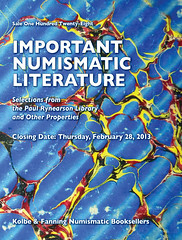 Kolbe & Fanning Numismatic Booksellers held their 128th mail-bid sale of important numismatic books on Thursday, February 28. Featuring selections from the Paul Rynearson library and other properties, the sale included standard works on ancient coins, as well as publications on medieval, foreign and U.S. numismatics.
Kolbe & Fanning Numismatic Booksellers held their 128th mail-bid sale of important numismatic books on Thursday, February 28. Featuring selections from the Paul Rynearson library and other properties, the sale included standard works on ancient coins, as well as publications on medieval, foreign and U.S. numismatics.
The sale had good participation, with some hotly contested lots:
—A complete set of the Forni reprint of the massive Corpus Nummorum Italicorum (lot 204) sold for $2415 (prices include the 15% premium)
—Albert Gallatin’s popular 1930 work on the Syracusan Dekadrachms of the Euainetos Type (lot 292) sold for $833.75
—G. Kenneth Jenkins’s important The Coinage of Gela (lot 399) sold for $862.50
—The Marquess of Milford Haven’s landmark British Naval Medals (lot 526) sold for $1207.50
—An 1871 broadside catalogue of a Bangs, Merwin & Co. coin sale (lot 889) sold for $575
—The complete presentation editions of the Bowers & Ruddy/Merena sales of the Garrett, Norweb, Eliasberg and Brand collections, as issued in three imposing volumes, one of only 15 possible sets (lot 914), sold for $4255
—A rare work by Walter Breen consisting of a text on California fractional gold with accompanying color slides (lot 927) sold for $920
—An unusually nice copy of the North American Fonrobert sale (lot 1246) sold for $1035.
The full prices realized list can be found on the Kolbe & Fanning website at www.numislit.com.
For more information on Kolbe & Fanning sales, please contact David Fanning at df@numislit.com or (614) 414-0855.
CZAHOR WWII AND PHILIPPINE MAIL BID SALE XVIII
Ray Czahor's Cookie Jar Collectibles Mail Bid Sale XVIII of WWII and Philippine books closes April 10, 2013. Howard Daniel writes:
There are many books in the first 250+ lots and other lots of interest to bibliomaniacs! Ray is located in Columbia, MD and I drive up to pick up my box of books from each of his auctions.
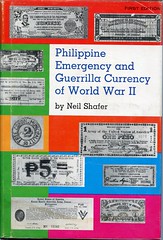 "Philippine Emergency and Guerilla Currency of World War II by
Neil Shafer. 1974. Hardbound, 464 Pages. The "Bible". With original pictorial dust cover
"Philippine Emergency and Guerilla Currency of World War II by
Neil Shafer. 1974. Hardbound, 464 Pages. The "Bible". With original pictorial dust cover
Springsteen, Jeffrey A. "The Final Research Report:/United States Territorial Coinage for the Philippine Islands/And The/Coins of the Culion Leper Colony" 1985. Stiff Cover, 70 pages. Detailed info on PI coins & varieties.
"U.S./Philippine Coins" by Lyman Allen, 1st Large Edition, signed by author. Stiff cover, 51 pages. Contains mintage figures and prices for all grades up to MS-65. Gives history of Philippine coinage, grading guide, many varieties with many photos.
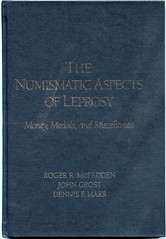 "The Numismatic Aspects of Leprosy, Money, Medals, and Miscellanea" by
Rodger R. McFadden, John Grost, and Dennis F. Marr 1993, Hardbound, 165 pages
Great section on Philippine Culion coins, paper money, and medals.
"The Numismatic Aspects of Leprosy, Money, Medals, and Miscellanea" by
Rodger R. McFadden, John Grost, and Dennis F. Marr 1993, Hardbound, 165 pages
Great section on Philippine Culion coins, paper money, and medals.
"History and Mintage/Philippine Counterstamped Coins/1828-1839" by Quint Jose MA. Oropilla Y Fortich, M.D.,2001. Hardbound (9 1/2" x 12 1/2"),250 pages w/dust cover. Includes photos of 15 rare C/Ss. Contains copies of original archival documents.(4 lbs for shipping)
"Philippine Medals" by Robert H. Reynolds 1998 (monograph No.12). Hardbound with dustcover, 96 pages. The "Bible" on details of Philippine Medals back to Spanish rule
WWII and PHILIPPINE MAIL BID SALE XVIII--March-April 2013
CLOSING DATE Tuesday, 10 April 2013
Cookie Jar Collectibles
PO Box 428
Savage, MD 20763-0428
Telephone: 301-604-9225
E-mail: cookiejarpi@verizon.net
NEW BOOK: A GUIDE BOOK OF U.S. COINS, 67TH EDITION
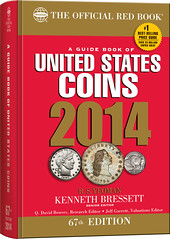 With the addition of 45 new photographs this year, the Guide Book of United States Coins (known to hobbyists as the “Red Book”) has a record-breaking 2,019 full-color images to help collectors identify and value their coins. The 67th edition, with a 2014 cover date, will debut in a special show-only offering March 14–17, 2013, at the Whitman Baltimore Coin & Collectibles Expo. In the meantime it can be preordered online (including at Whitman.com) and will be in bookstores and hobby shops nationwide on April 16.
With the addition of 45 new photographs this year, the Guide Book of United States Coins (known to hobbyists as the “Red Book”) has a record-breaking 2,019 full-color images to help collectors identify and value their coins. The 67th edition, with a 2014 cover date, will debut in a special show-only offering March 14–17, 2013, at the Whitman Baltimore Coin & Collectibles Expo. In the meantime it can be preordered online (including at Whitman.com) and will be in bookstores and hobby shops nationwide on April 16.
The 2014 edition prices 7,560 entries in up to 9 grades each, with more than 32,500 valuations in total. Extra pages have been added to the bullion and commemorative-coin sections, and all of the U.S. Mint’s circulating coins have been updated with new data. The 2014 Red Book includes 108 new coin issues, and 9 additional die varieties have been listed in older coin series. A new appendix tells the story of the 1794 silver dollar that broke all auction records when it sold in January 2013 for $10 million—an optimistic sign for the future of the hobby, according to the Red Book’s editors.
Another new appendix promotes membership in the American Numismatic Association as a valuable resource for coin collectors. It lists ANA member clubs by state, with contact information.
As in past years, collectors will benefit from recent auction records provided for significant rare coins. “Peppered throughout the chart listings are 169 notable auction results,” said Valuations Editor Jeff Garrett. “These, combined with the listed retail prices, help advanced collectors understand today’s market for high-end rarities.”
In addition, the appendix of the “Top 250 U.S. Coin Prices Realized at Auction” has been fully updated. Since the last edition, seven more coins have broken the $1 million mark, for a new total of 52.
“This year I find it interesting to note that parts of the market have moved in different directions,” said Red Book Senior Editor Kenneth Bressett. “Scarcer coins, especially those in high grade, are very much in demand while many typical collector pieces are in the doldrums, perhaps offering strategic buying opportunities. Certain perennial favorites continue to be popular and show price increases, while those items that are by necessity tied to bullion tend to be unpredictable at any level.”
Research Editor Q. David Bowers, commenting on the Red Book’s continuing popularity (more than 23 million copies have been sold since 1946), reminisced, “In 1952, at the age of 13, I received some Whitman penny boards as a gift. My first purchase after that was a Red Book, and ever since then I’ve kept a current copy close by. The Red Book improves with age, and the 2014 edition is the best of all.”
Mintage figures for all circulating coins and commemoratives have been updated as currently as possible with official data from the U.S. Mint.
Appendix B, “Collectible Red and Blue Books,” has also been expanded with more grades and information. A first-edition (1947) Red Book is worth $1,700 or more in New condition. Other numismatic updates in the 2014 Red Book include new text and images for the New Spain (Texas) jola tokens, and a new section on 1964 Special Strike coins. The book features expanded coverage of the 2009 Lincoln Bicentennial cents, modern Jefferson nickels, and M.E. Hart’s “Coins of the Golden West” tokens. New and ongoing research in numismatics led to many updates. Several long-standing mintages were modified, and a dozen existing listings were revised for greater accuracy.
In what Whitman publisher Dennis Tucker describes as a good measure of the health of the hobby, the listings in the Red Book’s numismatic bibliography include 25 standard references published within the past five years.
About the Guide Book of United States Coins
A Guide Book of United States Coins is the world’s most popular annual retail price guide for U.S. coins, tokens, and other numismatic items. More than 23 million copies have been purchased since 1946, making it one of the best-selling nonfiction titles in the history of U.S. publishing. For the 67th edition, more than 140 professional coin dealers, scholars, and other numismatic experts contributed their knowledge under the direction of Senior Editor Kenneth Bressett, Valuations Editor Jeff Garrett, and Research Editor Q. David Bowers.
The 67th edition of the Red Book will be available in April 2013, online and at bookstores and hobby shops nationwide. A limited number of advance copies will be available for purchase at the Whitman Baltimore Expo, March 14–17. In addition to offering a Large Print Edition and several formats of the regular edition (hardcover; spiralbound softcover; and spiralbound hardcover), Whitman Publishing is also taking pre-orders for the leather-bound Limited Edition (1,000 copies autographed by Bressett). For more information and to order, the Whitman web site is www.Whitman.com. The publisher is offering free shipping on every order placed online that includes a 67th-edition Red Book, through April 16.
448 pages
Full color
By R.S. Yeoman; senior editor Kenneth Bressett; research editor Q. David Bowers;
valuations editor Jeff Garrett
$14.95 spiralbound
$16.95 hardcover
$19.95 spiralbound hardcover
$29.95 Large Print Edition
$69.95 leather-bound Limited Edition (1,000 copies)
BOOK REVIEW: MONUMENTAL MONEY: PEOPLE AND PLACES ON U.S. PAPER MONEY
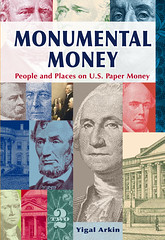 Monumental Money: People and Places on U.S. Paper Money
Monumental Money: People and Places on U.S. Paper Money
Yigal Arkin: Arkin Publishing, 2012
ISBN 978-0-615-46454-1. Pp. 112. $17.95
Yigal Arkin has brought a breath of fresh air and a colorful approach to the study of our federal currency. Monumental Money is most decidedly not for the specialist, the person who knows the convoluted story of our paper money inside out. But it is the perfect publication for members of a wider, more disparate group, including those who’ve always collected American coinage but are now thinking of branching out into paper; those seeking to interest others in a major area of our numismatic history; and anyone who’s ever looked at our currency and wondered who appeared on it, and why. Through a combination of fresh writing and colorful images, Arkin reaches out and captures the interest of these and other readers, creating a new audience for the appreciation of America’s paper.
Like ancient Gaul, this book is divided into three parts. ( Anyone who ever had to slog through First-Year Latin will recognize my reference. Those who don’t recognize it, be grateful). The first section gives a highly readable, well-illustrated survey of the money we see every day, but adds interesting facts we are unlikely to have encountered. (Did you know that Thomas Jefferson had Monticello’s floors painted grass-green in an attempt to bring the outdoors indoors? I didn’t; but it somehow sounds like something our Third President might have cooked up.) Part One concludes with the ill fated, redesigned hundred-dollar bill: Arkin’s photograph affords his readers the clearest glimpse of the new note they are likely to find – at least for the time being. Part One takes up a bit more than half the book.
Part Two embraces most of the remainder, and it consists of an excellent survey of our earlier paper money – anything and everything in commerce before the universal, and surprisingly recent, sway of the Federal Reserve note. Arkin touches briefly on colonial currency, but his main focus is on the various forms taken by federal notes, many of whom the beginning collector is unlikely to know well, if at all. He begins with an excessively rare treasury note from the War of 1812, but his survey really gets under way at the beginning of the 1860s: the sectional tensions that turned into a shooting war in 1861 completely transformed our paper money, as both Abraham Lincoln and Jefferson Davis sought and found new types of currency to finance the mayhem.
In the North, demand notes were one result, legal tender notes another, and fractional currency and national bank notes others still. Most of this money went by the name greenbacks, an allusion to the color adopted for back printing, one supposedly immune to photographic counterfeiting. And in the South, a tint called China Blue resulted in an analogous term for Confederate money, bluebacks. I call out the author’s explanation and coverage of national bank notes for particular praise. He makes one of the most confusing forms of our federal currency intelligible to beginners and intermediates alike.
The final portion of the book illustrates those notes about which all of us have heard, but which none of us are likely to have seen – the legendary high denomination issues, ranging from the five hundred-dollar bill (chump change), through the five thousand-dollar note (alright, now we’re talking real money), and on to the hundred thousand-dollar gold certificate (whoa!). His illustrations are superb, his thumbnail biographies of those gracing the money always informative – and his bringing together of this material performs a useful service for those collectors who like to get all their dreaming done in one place.
A decent index and finding guide for illustrations complete the work.
I found the book interesting, enjoyable – and I’d recommend it to anyone curious about our currency, how it originated, the stages through which it has gone, why it looks the way it does. As a Smithsonian curator, I occasionally have the privilege of recommending outstanding books to museum visitors. Since Yigal Arkin’s Monumental Money has already won my enthusiastic approval, I’ve chosen it as the “Curator’s Choice” at the National Museum of American History.
From the publisher's web site:
ISBN: 9780615464541
Author: Yigal Arkin
112 Pages
Trim size: 6.5 x 9.5
$17.95 (CAN $19.95)
For more information, or to order, see: www.arkinpublishing.com
To read an earlier E-Sylum article, see: BOOK REVIEW: MONUMENTAL MONEY: PEOPLE AND PLACES ON U.S. PAPER MONEY (www.coinbooks.org/esylum_v15n26a08.html)
BOOK REVIEW: LOST WORLD OF THE GOLDEN KING
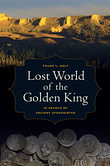 Before Americans toss out the use of coins in everyday transactions, numismatic scholars want people to know how important coins really are.
Before Americans toss out the use of coins in everyday transactions, numismatic scholars want people to know how important coins really are.
An example of that is the discovery of an ancient kingdom traced through the study of old coins, as detailed in a new book called, "Lost World of The Golden King - in search of Ancient Afghanistan," by University of Houston history professor Frank L. Holt.
"Coins are a historical document," said RyAnne Scott, communications coordinator for the American Numismatics Association. Yes, numismatics is a difficult word to pronounce and according to the dictionary it is the collection or study of money, both in coins as well as paper notes.
"If there is not a lot of surviving artifacts, coins can tell a great deal about the culture that produced it," Scott said.
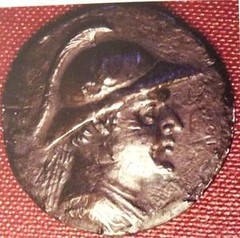 Holt is a Hellenistic scholar who has written three other books all focused on the rediscovery of the ancient world, especially in remote places often neglected and forgotten. In his most recent book, "Lost World of The Golden King," Holt was able to locate the ancient civilization of Bactria in what is now part of Afghanistan.
Holt is a Hellenistic scholar who has written three other books all focused on the rediscovery of the ancient world, especially in remote places often neglected and forgotten. In his most recent book, "Lost World of The Golden King," Holt was able to locate the ancient civilization of Bactria in what is now part of Afghanistan.
Despite the current violence and upheaval that presently scars that part of the world, Professor Holt got his research done. He sheds light on the fact that for centuries Bactria was a center of culture and commerce.
"I am acquainted with Frank's other book, "Into the Land of Bones, Alexander The Great in Afghanistan," said ANA Museum curator Douglas Mudd. "I am also familiar with the ancient kingdom of Bactria, it is very interesting because it is part of Alexander The Great's conquest," said Mudd.
To read the complete article, see: A Hoard of Coins Leads History Professor to Lost Ancient Kingdom (www.digitaljournal.com/article/344690)
To read the earlier E-Sylum article, see: NEW BOOK: IN SEARCH OF ANCIENT AFGHANISTAN (www.coinbooks.org/esylum_v15n43a06.html)
THE BOOK BAZARRE
THE SUPERIOR GALLERIES JERRY BUSS COLLECTION CATALOG
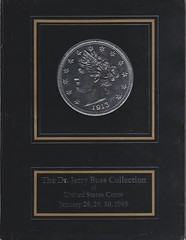
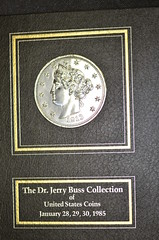
I never had the pleasure of meeting Dr. Buss in person, but did have an enjoyable experience with him in 1989.
Some years before this I had decided to collect autographed numismatic books, auction catalogs and other printed treasures. I had recently obtained a hard bound edition of the Buss Collection sale by Superior Galleries from 1985 featuring the embossed 1913 Liberty Nickel on the cover. I wrote to Dr. Buss informing him of my collecting interests and asked if he would do me the favor of autographing my catalog. I did not fully expect a response from a multi-millionaire for such a mundane request.
On November 6th 1989 Dr. Buss wrote a short note to me informing me he would "be happy to autograph your book." I sent the auction catalog to him with money for the return trip. I soon received my autographed catalog back in the mail complete with my return postage.
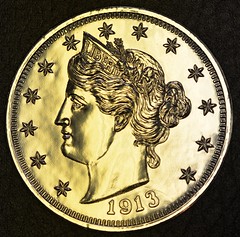 This is one of my favorite hard bound auction catalogs in my collection. The embossed 1913 nickel on the cover is very striking. Many, however, come hairlined from improper storage. One needs to be very careful in storing the catalog to prevent rubbing the relief of the image against other books when removing it from the shelf. I keep mine in plastic to prevent this damage. Inside, the first plate is dedicated to the "big three" coins in the sale; 1913 Liberty Nickel, 1894-S Barber Dime, and the 1804 Bust Dollar. Five more color plates of stunningly beautiful coins follow.
This is one of my favorite hard bound auction catalogs in my collection. The embossed 1913 nickel on the cover is very striking. Many, however, come hairlined from improper storage. One needs to be very careful in storing the catalog to prevent rubbing the relief of the image against other books when removing it from the shelf. I keep mine in plastic to prevent this damage. Inside, the first plate is dedicated to the "big three" coins in the sale; 1913 Liberty Nickel, 1894-S Barber Dime, and the 1804 Bust Dollar. Five more color plates of stunningly beautiful coins follow.
Include in a slot in the back of the catalog is a pre-sale advertising circular for the sale including an order form for the deluxe hard bound catalog at $25! The circular features a biography of Dr. Buss and large color photos of the "big three" coins with history and pedigree information.
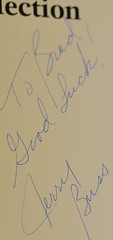 There is also a copy of the prices realized list in the slot. Gross sales of the sale of $3,640,110.65 are proudly featured on the cover. Inside the cover is a review of four of the most expensive coins from the sale. Lot 366 was the 1913 Nickel at $385K, lot 617 was the 1894-S dime selling for $50,600, lot 1337 represented the 1804 dollar at $308K and lot 1766 was an 1879 Coiled Hair Stella which sold for $104,500. Not mentioned here was lot 2101, a double Pan-Pac set in original copper frame which sold for $176K! All prices here include the 10% buyers fee charged at that time.
There is also a copy of the prices realized list in the slot. Gross sales of the sale of $3,640,110.65 are proudly featured on the cover. Inside the cover is a review of four of the most expensive coins from the sale. Lot 366 was the 1913 Nickel at $385K, lot 617 was the 1894-S dime selling for $50,600, lot 1337 represented the 1804 dollar at $308K and lot 1766 was an 1879 Coiled Hair Stella which sold for $104,500. Not mentioned here was lot 2101, a double Pan-Pac set in original copper frame which sold for $176K! All prices here include the 10% buyers fee charged at that time.
It was fun having an excuse to pull this old friend off the shelf for a few minutes of reminiscing. I am happy to know that Dr. Buss enjoyed sharing a brief moment of his numismatic time with me.
To read the earlier E-Sylum article, see: GERALD "JERRY" BUSS 1934 -2013 (www.coinbooks.org/esylum_v16n08a06.html)
WILLIAM COWBURN 1955-2013
 It is with deep sadness we report the passing of Bill
Cowburn, age 58 years, who, after a lengthy and
courageous battle against cancer and surrounded by
family and friends, expired on February 24th in his
York, PA home. Among other things, Bill was a
long time proud LSCC and ANA member, and Trade
Dollar Specialist. Many of us will remember Bill for
his extremely friendly, hearty laugh and great sense
of humor. He is survived by his wife of 12 years,
Laura, and many family members and friends.
It is with deep sadness we report the passing of Bill
Cowburn, age 58 years, who, after a lengthy and
courageous battle against cancer and surrounded by
family and friends, expired on February 24th in his
York, PA home. Among other things, Bill was a
long time proud LSCC and ANA member, and Trade
Dollar Specialist. Many of us will remember Bill for
his extremely friendly, hearty laugh and great sense
of humor. He is survived by his wife of 12 years,
Laura, and many family members and friends.
According to his obituary published in York Daily Record & York Dispatch, upon graduation from William Penn High School in 1972, Bill worked for a short time at York Borg-Warner Co. and then served York City as a Police Cadet. He then worked as an armored car driver with Loomis Armored Car while pursuing an accounting degree from York College. Upon graduating in 1992, Bill entered employment with the Pennsylvania State Comptroller's Office and was most recently employed with the Pennsylvania School Employees Retirement System.
Bill enjoyed playing and watching tennis, enjoyed growing fresh vegetables in the garden, and loved their dog, Rusty, who died last summer. Bill enjoyed the music of Bob Dylan and Frank Sinatra and traveling and learning about the history of our states and our country. His latest trip was whale watching in Hawaii with his wife to celebrate a wedding anniversary.
His books of choice were biographies of our Presidents and noteworthy historical events. He was highly respected for his knowledge in numismatics and has given countless seminars on the hobby, published various articles and has received numerous awards for his achievements in this field. Bill's life can be best summarized by the above quote.
According to Bill’s numismatic autobiography Bill was a collector for over 30 years and has a great deal of knowledge of the Bust and Liberty Seated series, especially Bust and Liberty Seated half dollars and Trade dollars. He has had numismatic articles published in The Numismatist, The Gobrecht Journal, The Centinel, and The Journal of the Barber Coin Collectors' Society. He won the Wagner Award as well as several awards for his articles including a Heath Literary Award from the ANA for his article "How Rare is Rare."
He exhibited and judged exhibits for several years. His exhibit "A Transitional 1876 Proof Trade Dollar" won 1st place in the U.S. Coin category and was 1st runner-up in the Best-of- Show judging at the 2006 ANA Convention. He was a speaker at the ANA Convention, FUN, CSNS, and PAN as well as at local clubs. He was Vice President of the York Coin Club, and supervised educational programs for that club and the Red Rose Coin Club. He served as president of the Red Rose Coin Club and was the Membership Chairperson for several years.
Bill was a member of ANA, LSCC, JRCS, BHNC, EAC, ANS, the Civil War Tokens Society, and several regional and local coin clubs. Bill also was a table assistant to Rich Uhrich.
We will all miss you, Bill. Rest in Peace.
For more information on the Liberty Seated Collectors Club, see: www.lsccweb.org
NUMISMATIC REFERENCES IN THE MAINE READER, 1614 TO PRESENT
Since my wife is from Maine, and we both attended the University of Maine at Orono, I picked up a book at a used book store – “The Maine Reader, the Down East Experience from 1614 to the Present,” edited by Charles and Samuella Shain.
I must admit that it was pretty dry reading to start, and I was ready to give it a pass. Then I came to excerpts from the diary of Benjamin Browne Foster. He was from Orono, and was apprenticed as a clerk to J. Brights Provision Stores in Bangor in 1847. The book only includes entries from July to October of this year. It is interesting to note that when giving values, he switches between dollars and pounds. A few passages are below - I thought others might find this interesting as well.
“Saturday, August 21: Found C.B. Abbot’s horse on the way to Glenburn. Carried him back to the Temperance House. Abbot offered me 3/ [ed. note: / referred to a shilling, six of which made a dollar] which, of course, I refused. If I had earned it, I should have taken it.”
“Monday, August 23, Orono, Maine: Went on board the Governor Neptune, the Oldtown and Passadumkeag steamer….The fare to Greenbush is 25 cents, to Passadumkeag, 3/.”
“Monday, September 13: Mother will be forty years of age tomorrow. Dear Mother, I never yet till now knew how much I loved her. Absence is the true touchstone. I gave her as a present an old American dollar of the date 1795 with the injunction not to spend it. I had and could think of nothing else.”
“Wednesday, September 22: Father and Mother were down this P.M. to see Tom Thumb for principal object. They, particularly Mother, were in raptures. They had his Lilliputian visiting card, given at the door, “Gen. Tom Thumb,” and they bought a gilt medal, on the obverse Victoria’s head and bust with the words, “Victoria Regina,” and on the reverse Tom Thumb’s likeness with the words, “General Tom Thumb, Weight 15 pounds.” For this they paid 9d. Also a pamphlet, with his description, his song, his travels. This was 4d.”
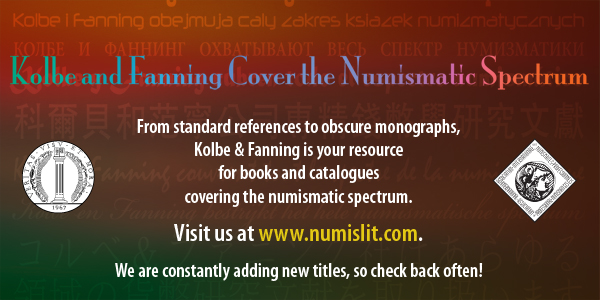
ERIC P. NEWMAN U.S. PATTERN SALE INFORMATION
Saul Teichman writes:
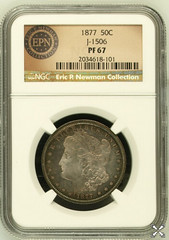 For those people who want to know which Newman coins Heritage will be offering, they are visible on NGC's website under 2034618.
For example, the Judd 1506 -
www.ngccoin.com/certlookup/CertResults.aspx?CertNumber=2034618-101
list goes from 2034618-001 (half cent pattern Judd-177) thru 2034618-161 (1845 Proof $1 from the cased proof set)
For those people who want to know which Newman coins Heritage will be offering, they are visible on NGC's website under 2034618.
For example, the Judd 1506 -
www.ngccoin.com/certlookup/CertResults.aspx?CertNumber=2034618-101
list goes from 2034618-001 (half cent pattern Judd-177) thru 2034618-161 (1845 Proof $1 from the cased proof set)
 More than 150 rarities from the pattern coinage collection of the Eric P. Newman Numismatic Education Society will be sold April 25 at the Central States Numismatic Society Annual Convention’s Official Auction, presented by Heritage Auctions in Schaumburg, Ill.
More than 150 rarities from the pattern coinage collection of the Eric P. Newman Numismatic Education Society will be sold April 25 at the Central States Numismatic Society Annual Convention’s Official Auction, presented by Heritage Auctions in Schaumburg, Ill.
Eric Newman is a legendary numismatic researcher and founding member of the CSNS.
Items being sold are from the extensive collection of Eric P. Newman Numismatic Education Society (a Missouri not-for-profit corporation) and have been assembled over a period of 90 years.
Proceeds of the sale of all items will be used exclusively for the benefit of other not-for-profit institutions selected by the Society and also for supplementing the Society’s own museum operations and scholarly research efforts.
“It is a great honor for us to offer this collection,” said Jim Halperin, co-chairman of Heritage. “Eric P. Newman is a titan of numismatics and one of the hobby’s greatest treasures.
This sale will help many worthy causes, including Eric’s tradition of adding to our knowledge about the history of money. The Newman family’s generosity is nothing short of inspiring.” Newman co-authored The Fantastic 1804 Dollar, the first comprehensive work on the mysterious and much-loved coins, and was the last person to own all five examples of another famous rarity, the 1913 Liberty nickel.
Through books and countless articles for numismatic periodicals, he has shared his knowledge with several generations of collectors.
The centenarian Newman remains active in numismatic research. He and his wife of more than 70 years, Evelyn, established the Newman Money Museum on the campus of Washington University in St. Louis, Mo.; Newman attended Washington University’s School of Law, receiving his Juris Doctor in 1935, and practiced law for more than a half century.
Though Newman is most famous for his work with early American coins and currency, he also assembled an extensive pattern collection. One of the rarest offerings is a 1915 Panama-Pacific half dollar without “S” mintmark, the Judd-1961 variety struck in silver, graded PR-65 by NGC. A companion piece, the Judd-1962, is identical except that it was struck in copper and is graded PR-66+ Red and Brown by NGC.
“Pattern coins of the 20th century are rare, and opportunities to own them rarer still,” said Halperin. “The 1915 Panama-Pacific half dollars without mintmarks were struck in gold, silver, and copper, but for each metal, fewer than four examples are known.”
An 1879 “quintuple stella” or $20 pattern has the proposed coin’s weight and composition spelled out between stars on the obverse in the style of the $4, or “stella,” patterns of the same year. The Newman example of the very rare Judd-1644 variety, struck in copper, is graded PR-64+ Red and Brown by NGC.
To read the complete article, see: Eric P. Newman Numismatic Education Society Sells Patterns (www.numismaster.com/ta/numis/Article.jsp?ad=article&ArticleId=26606)
QUERY: WHEN WERE 1804 DOLLAR LETTERS WRITTEN?
Sharp-eyed reader Dave Hirt writes:
Very soon I will be returning to the U.S., but I'm still away from my library, so perhaps you can make sure my memory is correct. Of course I never feel too far away when I can read The E-Sylum each week.
In the item by Mark Ferguson on H. O. Granberg it mentions letters written by William Idler in 1908. I believe Idler died in 1901 at an advanced age. Perhaps the letters were written by his son-in-law, John Haseltine.
Mark responds:
Yes, I stand corrected - I wrote that statement from memory, which must be like Ken Bressett's on this subject - he once told me he forgot more than he remembers about 1804 Dollars.
One letter is dated October 19, 1908 at Philadelphia, PA. It is on stationary from H.O. Granberg and the last page is missing. However, I have what appears to be a proof sheet from Mehl's Numismatic Monthly, page 65, that has the remainder of the letter and it is signed by John W. Haseltine. The Newman-Bressett Fantastic 1804 Dollar book states the letter appeared in the April, 1909 Mehl publication. I am guessing Haseltine and Granberg were both together in Philadelphia when the letter was written and that's why the letter was on Granberg's stationary, but who knows?
And yes, the other letters are also signed by John W. Haseltine and they are dated March 5th and 16th, and July 15, 1910. The letter from July is on Haseltine's letterhead, and the other two appear to be on plain paper. I remember reading somewhere that Granberg may have taken about two years to complete his purchase of the Idler 1804 Dollar - so the 1908 to 1910 period makes sense. I am looking photocopies of the original letters which I sold to Aubrey Bebee after he acquired the coin and before he gave the coin to the ANA.
I put the original letters in sheet protectors and a three ring suede binder and that's the way Aubrey took possession of them; however people from the ANA claim they never received them. I called Adeline Bebee at least twice after Aubrey's passing, but she didn't know of these letters or their whereabouts. Let me know if I can be of further help.
Great catch by Dave Hirt!
Dave adds:
If Idler wrote the letters in 1908, I would be very curious to see the return address.
Mark adds:
Had Idler written them they would be "heaven sent." Haseltine's return address was: "29 S. 17th Street, Philad'a."
To read the earlier E-Sylum article, see: MARK FERGUSON, H.O. GRANBERG, AND THE DEXTER 1804 DOLLAR (www.coinbooks.org/esylum_v16n08a10.html)
NOTES FROM E-SYLUM READERS: MARCH 3, 2013
Comments on South Asian Coins and Paper Money – Indian Edition
Kavan Ratnatunga writes:
I remember objecting to both George Cuhaj and the Indian editors for reusing an old title of a classic catalog published in 1982 of South Asian coins for a catalog of Indian coins excluding the other South Asian countries. I hope the use of the term Indian Edition, implies that someday in the Future there will be Editions for Sri Lanka Pakistan, Nepal, Burma, Afghanistan, Maldives etc.
To read the earlier E-Sylum article, see: NEW BOOK: SOUTH ASIAN COINS AND PAPER MONEY – INDIAN EDITION (www.coinbooks.org/esylum_v16n08a04.html)
Meeting Ruth Hill
Bill Rosenblum writes:
The recent posting about Ruth Hill remind me of a flight my wife Rita and I took 30+ years ago. I believe we were traveling to either the 1980 ANA in Cincinnati, which was among the best shows we ever had, or the 1981 ANA in New Orleans which was among the worst ever although our dining experiences almost made up for the lack of sales and purchases. I believe we had to change planes in St. Louis and while we waited in the boarding area we noticed Mrs. Hill sitting there wearing white gloves and a 1950s style hat.
Traveling was a bit more formal 30 years ago but Mrs. Hill was still the most "proper" looking person in the airport. I'm sure very few people knew that there sat one of the most knowledgeable and influential people in the area of world-wide numismatics. She kind of looked a bit unapproachable but of course we knew her and had a nice conversation while awaiting our flight. By the way, it's also possible that this meeting could have happened while we were returning from one of the show and we may not have even been on the same flight. It was a long time ago.
That reminds me that our hobby or "community" as Cliff Mishler likes to call it attracts all kinds of people. There are people who when you see them you think "I should cross the street, he looks kind of scary (or fill in the word)" but if you have numismatics (using the broad term to include all facets of the hobby) in common it's amazing how much we can enjoy and learn from our conversations. Sometimes the local coin clubs are the best barometer of this bringing together high rolling "pillars of society" such as doctors, lawyers and Indian chiefs as well short-order cooks, minimum wage workers and kids who have a great thirst for knowledge but have little or no money or acquire coins, medals, tokens, banknotes or even books.
To read the earlier E-Sylum article, see: MORE ON THE RUTH HILL WORLD BANKNOTE COLLECTION (www.coinbooks.org/esylum_v16n08a07.html)
Query: Zabriskie Sale Lot 358 Buyer Sought
Mark Borckardt writes:
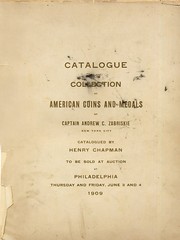 I am searching for someone who owns a named copy of the Chapman 1909 Zabriskie sale. I specifically need to know who purchased Lot 358. It is an 1852 Humbert $10. Perhaps an E-Sylum reader can help.
I am searching for someone who owns a named copy of the Chapman 1909 Zabriskie sale. I specifically need to know who purchased Lot 358. It is an 1852 Humbert $10. Perhaps an E-Sylum reader can help.
Who Created the Distinguished Warfare Medal?
Regarding Howard Daniel's comment on the Distinguished Warfare Medal ("To create a medal for a rear echelon person....."), Gar Travis writes:
These "persons" are in fact pilots and some are government contractors; albeit remote in nature and not so different than Air Force bomber pilots dropping ordinance high and away from the intended target. I am a veteran as well and am no way "offended" enough in this time of modern warfare to consider contacting my Congress representative, as they have more than enough to do, without my having an issue with either the significance or the awarding of such a medal.
Times have changed and sometimes we do not like it, nor do we have control of it. While the administration of President Obama was seemingly blamed in the creation of this award, we must remember that someone in the military services created this honor and when all was said and done from a military and Congressional standpoint; it was finally approved by the Executive Branch. It should not be politicized as the fault of the administration but, as perhaps a poor choice of decided heroism placed by the Pentagon on the awarding of the medal.
To read the earlier E-Sylum article, see: NOTES FROM E-SYLUM READERS: FEBRUARY 24, 2013: More on the Distinguished Warfare Medal (www.coinbooks.org/esylum_v16n08a08.html)
Commemorative Coins Encyclopedia "Investment Section"
Michael Sanders of Beaverton, OR writes:
I too have always been fascinated by the curiously demeaning tone and the blatant sales promotion found in the Swiatek - Breen "Encyclopedia of United States Silver & Gold Commemorative Coins". The last section titled "The Investment Section" is particularly upsetting. Each Commemorative is listed in 3 grades with the 1985 price and the projected 1990 price. The first series of prices are highly exaggerated and the projected prices are pure fantasy. Today most of these coins are worth a fraction of the prices listed. Yes, I certainly want to sell my MS-65 Fort Vancouver for $17,000.00!
I knew Walter Breen and spoke with him at many California coin shows prior to his arrest and incarceration. I once asked him about this reference and he told me "I was paid for it but I am not in the least proud of it". His research and writing style define this book but he would say no more. Enough said!
To read the earlier E-Sylum article, see: FIRST COINVESTORS AND THE SWIATEK-BREEN COMMEMORATIVE BOOK (www.coinbooks.org/esylum_v16n08a15.html)
The Mystery Cat
Regarding the earlier discussion of the "rolling coin" video, Fred Michaelson writes:
I saw this too late to comment last week, but I did notice that at minute 42 a cat walks by.
To read the earlier E-Sylum article, see: NOTES FROM E-SYLUM READERS: FEBRUARY 24, 2013 : Quiz Answer: The Rolling Coin Was ... (www.coinbooks.org/esylum_v16n08a08.html)
MORE ABOUT COINAGE MAGAZINE ARTICLES ON CHINA
I have my own index, which I kept from the mid-70s to the mid-90s. Some of it was done by Barbara Parrotto, who was ny personal secretary (and a former editorial assistant in the NLG newsletter) who worked in my home office a few days a week when my children were young.
COINage was my friend Jim MilIer's publication almost from the time that he brought it out with Gordon Behn in 1964. My set is bound though about 1994, and in pocket-holders afterwards.
COINage had the best stable of writers in the field and, in Ed Reiter, one of the best editors. (I wrote for them for more than 30 years, from 1971 until just after Jim MIller's death in 2003. Excluding my own contributions (and those articles numbered in the hundreds over the years and included substantive articles as well as "scoops" over the weekly competition in Coin World and Numismatic News. I think you will find that the American Numismatic Society in its "Numismatic Literature" indexed many more articles in COINage than any other domestic periodical.
My index lists the following:
People Numismatist in China (COINage V14 1978) Jun
World Masterpieces of China (COINage V15 1979) Aug
World The China Connection (COINage V15 1979) Oct
People Inside the China mint (COINage V20 1984) Apr
A Collector in China (Ganz) (COINage V31 1995) p44 May
Personalities Yank in the China Mint (COINage V7 1971) Dec
I will be happy to go into my library and fact-check for Bruce. I am missing only an issue or two in year 1 or 2 to be fully complete.
To read the earlier E-Sylum article, see: QUERY: COINAGE MAGAZINE ARTICLES ON CHINA SOUGHT (www.coinbooks.org/esylum_v16n08a17.html)
QUERY: CHICKEN COUNTERSTAMPS
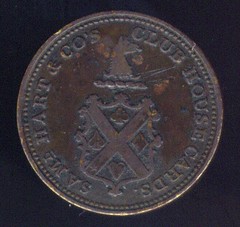

In the "what the cluck is this?" department, Gene Brandenburg writes:
I recently came across an unusual piece - a rather common circa 1850 N.Y. merchant token with a chicken counterstamp. I ran this past Dave Schenkman and he told me that he had seen chicken counterstamps on old tokens before but he did not know the reason or origin. I tried to "egg" him on further but he felt I was running "afowl" of his patience so I backed off. Any cooped up E-Sylum savants out there have any knowledge or ideas on this countermark? Only a thought, this would be a wonderful addition to an advanced barnyard collection that included say...a goat tag. I could bring this to the next Nummis Nova dinner but any media attention would probably mean SRO (standing room only) and crowd control would be advised.
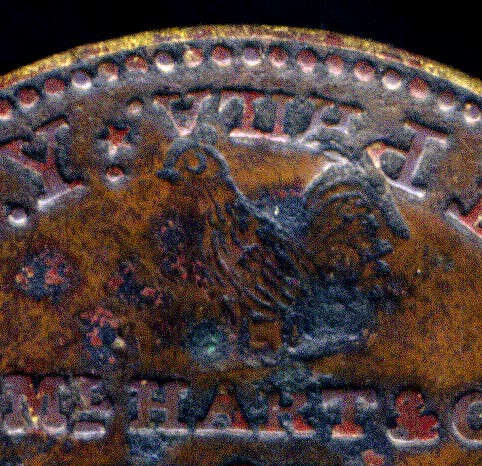
THE BOOK BAZARRE
MORE ON THE NUMBER OF COUNTRIES IN THE WORLD
Ken Berger writes:
I see no problem with the various number of countries because it does state that they are coins of currently existing countries. Thus, it is quite easy to have coins from 100's, if not 1000's, of different countries. Just think, how many different countries have existed from the past to the present?
Arthur Shippee writes:
Is the answer not trivial? I imagine the collections include money from countries that no longer exist. Does the record stipulate current countries? And who gets to define what a country is, anyway?
Paul Schultz writes:
In the last E-Sylum, ASR Murthy of Madras (Chennai) wonders what the Guinness uses for definition of a "Country" since numismatic collections can contain more countries than the current UN roster.
It must be pointed out that the total number of current countries (independent nations) in the world is 196, according to the UN.
People collecting bank notes do not necessarily collect just current countries. Add in East Germany, Czechoslovakia, the Confederate States of America, etc and I'm sure you can reach the 221 that Sanjay Relan of Hong Kong has.
With coins, the 255 that Justin Gilbert Lopez has is even easier to explain, but probably very time consuming to collect. In the 1700s and 1800s, so many cities in Germany were truly fully independent countries (the German states, unified only by rather similar cultures and languages) that they alone could make up the difference, although other regions such as Italy were also composed of many independent entities.
The information in Guinness is not misleading, it only requires the recollection that historical collections must recognize many more countries than the present UN organization.
Bob Lyall writes:
I note with interest the question of how many countries there are in the world. So how does Northern Cyprus rate? I think the Turkish would say it was a separate country and for many many years residents and tourists were unable to cross from one to the other although I believe it is a little more relaxed now.
Ron Guth writes:
Those guys with 221 to 255 coins from around the world are what the young people today call "weaksauce." Visit the "everycountry" group at ca.groups.yahoo.com/group/everycountry/ and try to collect one of each "place" on their 7,500 line checklist!
To read the earlier E-Sylum article, see: HOW MANY COUNTRIES ARE THERE IN THE WORLD? (www.coinbooks.org/esylum_v16n08a18.html)
DAVID GANZ RECALLS HIS TRAVELS AND WRITINGS
The UN web site says "There are the 192 Member States of the United Nations with dates on which they joined the Organization, following the admission Montenegro on 28 June 2006." Wikipedia notes “The list contains 206 entries. The states are divided using two distinct methods:
1. The membership within the United Nations system column divides the states into two categories: 193 member states[1] and two observer states, and 11 other states.
2. The sovereignty disputes column divides the states into two categories: 16 states whose sovereignty is disputed and 190 other states.
Back in the day, around 1945, the world had probably (about) 75 countries, many of which were pink colored on the map (Great Britain influenced). There were also about 14 countries that whose existence was doubted by some one or the other – they existing ones are either League of Nations or United Nations members.
I remember when I started to travel internationally (about 1975) that I was pretty sure that it would be possible to go to most of the countries in the world, and that became a bucket list of sorts. Since then, my wife Kathy & I have had a wanderlust for travel and have visited all seven continents (we went to Antarctica before we made it to Australia); many of our friends (and a number of your readers) received copies of the travelogues that I still write when we travel. In a reduced and more numismatically focused way, they have mostly wound up in my "Under the Glass" column that has been running in Numismatic News since 1969 or so.
Anyhow, we now have visited more than 75 countries and hope to add a few more this year, including Ireland (which I visited as a result of a refueling stop coming back from Rome in 1975, where I attended law school (studying international law) for a semester, while also working for the Money Office of the Food & Agriculture Organization of the United Nations (FAO). We are hoping in November to add Morocco to our listing as well.
All this is good, because at 61, I am no longer a youngster, and am starting to run out of time to see them. I started serious writing in 1965 for the Coin Shopper (a Texas house organ), and then shifted over to the Lawrence Brothers' "The Coin Collector" which was published out of Anamosa, Iowa, My "Under the Glass" column ran in Numismatic News from 1969-1976, then moved to Coin World for 20 years (different column name) and since 1996 I have been writing the UTG column for Numismatic News, as well as a lot of books, some of which are coin related, some of which are law related, and one on African literature.
So, as 2013 starts, I have been writing about coins in the Sixties, Seventies, Eighties, Nineties, Oughts, Tens and the Teens, or over seven decades!
You know the coin books that I’ve written, but there are about a dozen book-length law-review articles that West (a leading legal publisher) has published and a few others that include coins [the Cleveland State Law Review published an article (page 175-257) on revising the minting and coinage laws] while the other legal include topics of 100 to 400 pages in length on civil rights laws, rent control, zoning, open public records act, and many other topics that I have been involved as a lawyer.
The book on African Literature is a critical guide to anthologies published prior to 1973, when it was still possible to say that you had read African literature in the way at the time of Shakespeare you could say that you had read English literature. I did an independent study project at Georgetown over a three year period (it was over my regular 120 credits) and the resulting project (appendix “o”) was published by the African Studies Association in 1973, as an academic work. (When I saw it on eBay in 2010, selling at around $98, I realized it was time to reprint it and offer it to any academic who had a genuine interest (at no charge).
To read the earlier E-Sylum article, see: HOW MANY COUNTRIES ARE THERE IN THE WORLD? (www.coinbooks.org/esylum_v16n08a18.html)
NATIONAL COLLECTOR'S MINT TO SELL 1794 SILVER DOLLAR REPLICA
National Collector's Mint is a critical player in today's commemorative and collectible coin industry, and as such, the company is keenly aware of news and happenings from the world of coin collection. In particular, the company's attention has been drawn to a report of a record-setting coin sale, held just recently and capturing the imagination of coin collectors from across the country. National Collector's Mint has issued a new statement to the press, commenting on this historic rare coin sale.
The sale in question involves a 1794 "Flowing Hair" dollar -- believed by many scholars and experts to be the very first silver dollar ever coined by the U.S. Mint. The incredibly rare coin was sold for a sum of some $10 million, just last month.
The sale is big news among coin enthusiasts, and, according to National Collector's Mint, it is reason to celebrate. "At National Collector's Mint, we are always excited by a record-setting coin," opines the company, in its new press statement.
The company goes on to make an important announcement. "We believe the public is excited, as well," says the company's press statement. "We'll test out that notion by trying to re-market our recreation of the 1794 Silver dollar to the general public, focusing on the story of this sale and highlighting the best aspects of the original, like the fact that many experts believe it to be the very first silver dollar ever minted by the U.S. Government."
To read the complete press release, see:
National Collector's Mint?: $10M Coin Sale Draws Attention of Collector Community
(www.marketwatch.com/story/national-collectors-mint-10m-coin
-sale-draws-attention-of-collector-community-2013-02-28)
FIRM MARKETS FANTASY TRILLION DOLLAR COIN
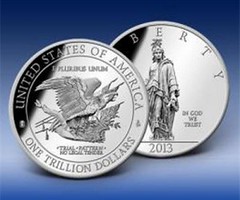 A Pennsylvanian coin and memorabilia dealer is selling a trial pattern of the proposed US trillion dollar coin, it announced last week.
A Pennsylvanian coin and memorabilia dealer is selling a trial pattern of the proposed US trillion dollar coin, it announced last week.
American Mint has created a copper coin layered with platinum to represent what the $1-trillion piece would look like if the US Congress were to approve it. The front of the coin features an American bald eagle with a symbol of "Liberty" on the reverse. The model retails on its website for $9.95.
Financial bloggers in the US floated the notion of a trillion dollar coin to address the nation's debt problems.
A technicality in US law says its Treasury has special discretion to create platinum coins of any denomination. The US Secretary of the Treasury could then deposit the coin in its bank account via the Federal Reserve. Afterwards, it could sell bonds to raise money to pay down the debt.
To read the complete article, see: Retailer sells model US trillion-dollar coin (www.mining.com/retailer-sells-model-us-trillion-dollar-70788/)
THE BOOK BAZARRE
ARTICLE PROFILES NICKEL CARVER ALEXSEY SABUROV
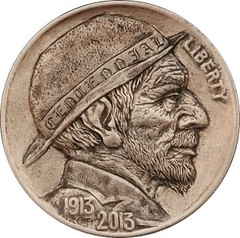 “As someone who’s creative by nature, I needed to seek out something new, a fresh direction to work on. The burden of the mundane, everyday production, where it all comes down to essential quantity and how fast you can make it, well, all that drove me to open up my browser and look for engraving projects on-line. Never expected it to be something called a Hobo Coin.”
“As someone who’s creative by nature, I needed to seek out something new, a fresh direction to work on. The burden of the mundane, everyday production, where it all comes down to essential quantity and how fast you can make it, well, all that drove me to open up my browser and look for engraving projects on-line. Never expected it to be something called a Hobo Coin.”
Aleksey is a master engraver, coming from the jewelry capital of Russia – Kostroma. It’s not a big city that has five (yes five) jewelry production plants and the very best European jewelers, designers and engravers, as well as the finest universities teaching these disciplines in a century-long tradition. This place is all about fancy design on precious metals. Aleksey holds the qualification title of the 6th degree master engraver, being of the highest category bestowed upon these craftsmen by the institution that prides itself as being unmatched in this field.
Today Aleksey continues to excel in the jewelry business, but every man needs a hobby, right? “A Hobo Coin seemed perfect from the start! This is it! A miniature bas-relief in metal, it’s like a tiny sculpture with a sense of tradition behind it. When I started reading up on Hobo Nickel and what it’s about, it was precisely down my alley! This is what I was taught and loved the most back in college days.”
To him engraving is like an old film development process: first you have the general shapes, but then all these details start coming out into the light. With Hobo Nickels, every coin is a challenge to apply the skills: to get the highest level of detail, the character right and not to miss the iconic traits of those times. It is a truly and deeply enjoyable work, a through back to the college days when projects were crafted for the pure joy of it, and every new one is a creative challenge.
For Aleksey the best subject matter is a portrait. This is one of the tougher ones, like passing a qualifications test every time. It’s not enough to be a good engraver, but also getting it to look like the person and capturing the so-elusive character of the face. Such challenge makes you feel like a first-grader, facing a monumental test of everything you’ve got. Never know if you’ll pass or fail.
Aleksey is indeed a master of his craft, who has found a hobby that is more than a hobby – a true joy to create, and the work really speaks for itself.
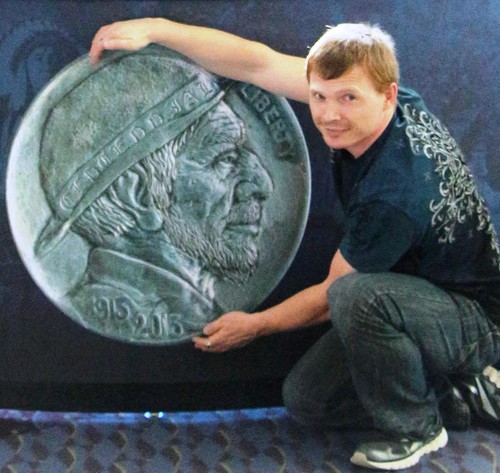
For more information on the Original Hobo Nickel Society , see: www.hobonickels.org
POG DESIGNER GRANT MORRIS TO SPEAK AT 2013 MPC FEST
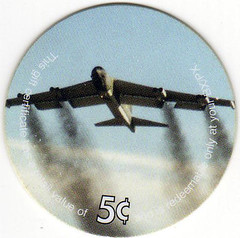 The person largely responsible for the AAFES (Army and Air Force Exchange Systems) gift certificates called POGs will tell the inside story at MPCFest on March 16. Grant Morris worked for AAFES for 25 years, 20 years as an executive and AAFES Treasurer 2001 to 2007. Significantly, that time overlapped the beginning of Operations Iraqi Freedom and Operation Enduring Freedom. He had control and responsibility of the POG program; specifically printings 2 through 10.
The person largely responsible for the AAFES (Army and Air Force Exchange Systems) gift certificates called POGs will tell the inside story at MPCFest on March 16. Grant Morris worked for AAFES for 25 years, 20 years as an executive and AAFES Treasurer 2001 to 2007. Significantly, that time overlapped the beginning of Operations Iraqi Freedom and Operation Enduring Freedom. He had control and responsibility of the POG program; specifically printings 2 through 10.
Grant reports traveling highlights during his tenure with AAFES included: Italy, Germany, Qatar, Kuwait, Iraq, Korea, Japan, Okinawa and Guam. He says that most interesting place he has been to while with AAFES; Cheyenne Mountain, Colorado Springs. The most moving places he visited were the mess hall in Bagdad and Brooke Army Medical Center, Ft. Sam. His favorite moment during he career was getting invited into a soldier’s remote hooch in Bagdad, where he and his host smoked cigars, and exchanged stories and pogs.
Grant's father was drafted into the Army and served as a Glider Pilot, in the Army Air Corp. He served in the European theater, in the 32nd Squadron of the Troop Carrier Command. Grant's father's brother, Gilbert, volunteered and served in the Army. Gilbert served in the Pacific theater in the Philippines, where he survived the Bataan Death March. The POG presentation will take place at approximately 2pm, Saturday March 16 at MPCFest. The presentation fits in the Fest theme of "The Design Process." The first part of that special program will be given by Len Buckley formerly of the Bureau of Engraving and Printing as previously reported.
Grant reports traveling highlights during his tenure with AAFES included: Italy, Germany, Qatar, Kuwait, Iraq, Korea, Japan, Okinawa and Guam. He says that most interesting place he has been to while with AAFES; Cheyenne Mountain, Colorado Springs. The most moving places he visited were the mess hall in Bagdad and Brooke Army Medical Center, Ft. Sam. His favorite moment during his career was getting invited into a soldier’s remote hooch in Bagdad, where he and his host smoked cigars, and exchanged stories and pogs.
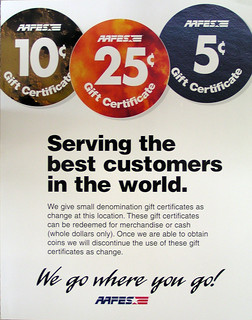 Grant's father was drafted into the Army and served as a Glider Pilot, in the Army Air Corp. He served in the European theater, in the 32nd Squadron of the Troop Carrier Command. Grant's father's brother, Gilbert, volunteered and served in the Army. Gilbert served in the Pacific theater in the Philippines, where he survived the Bataan Death March.
Grant's father was drafted into the Army and served as a Glider Pilot, in the Army Air Corp. He served in the European theater, in the 32nd Squadron of the Troop Carrier Command. Grant's father's brother, Gilbert, volunteered and served in the Army. Gilbert served in the Pacific theater in the Philippines, where he survived the Bataan Death March.
The POG presentation will take place at approximately 2pm, Saturday March 16 at MPCFest. The presentation fits in the Fest theme of "The Design Process." The first part of that special program will be given by Len Buckley formerly of the Bureau of Engraving and Printing as previously reported.
The special presentation (as well as the other twenty or so presentations) is free to Festers (collectors registered for MPCFest. However, because of the special nature of the design presentations, public participation is invited. Ten seats are reserved at $20 each for anyone interested in attending the design presentations (but not the balance of the Fest activities). Contact Fest general chairman (officially called the battalion clerk!)) Fred Schwan 419 349 1872 or fredschwan@yahoo.com.
Grant Morris's appearance at MPCFest is sponsored by Steve Swoish and other collectors who are interested in spreading the word about POG collecting.
For more information on the MPC Gram, contact: MPCGram@yahoo.com
The MPCFest bourse is the most unique such event in the country in many ways. Of course it is the only bourse in the world specialized in military numismatics--especially paper money. It features full and part-time dealers as well as collectors selling a wide variety of numismatic material, but emphasizing military money. In all cases the table holders are certain to have interesting items for sale, and, of course, they want to buy as well. It is also believed to be the only Friday bourse in the country.
Unlike MPCFest, the bourse is open to the public: everyone interested in numismatics is invited. Specialty collecting groups also meet during bourse hours. The public is invited to these meetings as well.
The Fest bourse is held at the Holiday Inn Express, 50 North East Catawba Road, Port Clinton, OH 43452. Admission to the Fest bourse and parking are free. Contact: bourse chairman DavidSeeley@gmail.com; general chairman fredschwan@yahoo.com (419) 349-1872; hotel (419) 732-7322.
2013 MPCFest Bourse public schedule
14 March
1900 Dinner at Liberty Air Museum Diner and tour
2100 Annual bowling fiasco
15 March
0830 bourse set up (David Seelye presiding)
0930 Military stamps collectors meeting (first ever?) (Ron Waddell and Roger Urce moderating)
1000 bourse open to the public
1200 Philippine Collectors forum, John Riley presiding in mess hall
1400 bond collectors’ meeting, Warner Talso and Jim Aitken presiding in mess ball
1500 JIM meeting, Neil Shafer presiding in bourse
1600 bourse closed to public
1700 bourse must be cleared
HARVEY STACK AND JOSIAH LILLY'S 1926-S DOUBLE EAGLE

I received an inquiry about the collection of $20 gold double eagles known to have been assembled by Robert Schermerhorn, which Stack’s acquired for Mr. Josiah Lilly of Indianapolis, CEO of the Lilly drug company in the early 1950s.
By late 1953 or early 1954 he decided to try for a complete set of U.S. double eagles. Around that time we were offered a nearly complete set of double eagles formed by Robert Schermerhorn of Texas and Mr. Lilly decided to buy it intact and then seek out the missing issues. Among the coins that were not in the collection was the 1926 San Francisco Mint issue. Despite searching at shows and in private collections, we were unable to find a 1926-S for him.
In order to attract attention to our search, in 1955 or 1956 we advertised offering a $500 reward to anyone who would tell us where we could get an example for $3,000. Initially there were no responses.
Shortly thereafter, at a convention, James Kelly came over to our dealer bourse table and dripped a coin on a pad and said to my father, “Mort, I claim the $500 reward.” When we looked it was a Choice 1926-S double eagle. My father asked Jim, “How much?” Jim said $3,000 of course and we paid it, plus the reward. My father was furious at Jim, but we got the coin. We sent a Western Union wire to Mr. Lilly to tell him we had found the last coin he needed and were billing him for $3,500. We felt our zeal had established a price beyond its value at the time.
Within two days or so afterward, there appeared several 1926-S double eagles on the floor, offered to us at prices ranging from $1,200 to $2,000. Naturally we refused, but did take an option on one for under $1,500 and contacted Mr. Lilly to ask him to return the original double eagle so that we could supply him one for less than half the cost. He replied, “You have spent close to two years trying to find the coin for me. I will take it at its original price as I feel you were taken in.” He also said that we had surely already saved him money by bargaining with the sellers when we found coins for him, and passing on those pieces that were overpriced. He felt we had done our job in good faith. For 17 years we built series after series of gold coins of the world for Mr. Lilly. The coins now reside in the National Collection at the Smithsonian Institution.
After this incident we learned that James Kelly partnered with Paul Witlin who had bank contacts in Europe and while going through coins, found a small hoard of 1926-S double eagles. They tried to sucker us in and make a killing, but in the end Mr. Lilly showed what kind of man he was and his appreciation for all the work we had done with him and for him.
To read the complete article, see: Remember When: Finding A 1926-S $20 In The 1950s (stacksbowers.com/Blogs/remember-when-finding-1926-s-20-in-1950s.html)
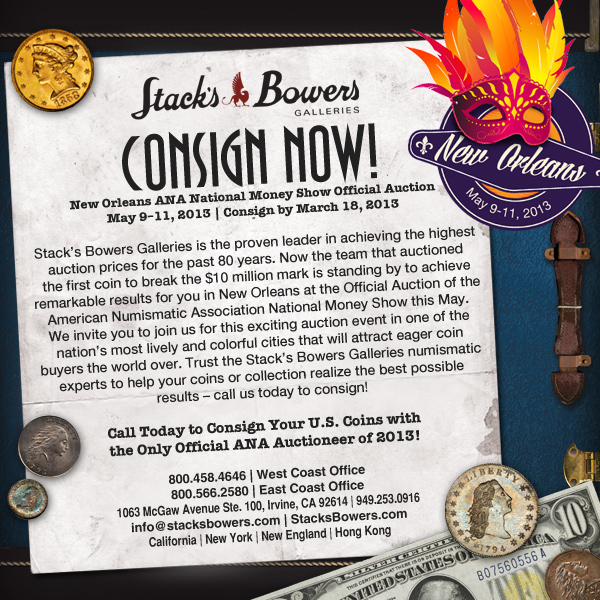
NATIONAL GEOGRAPHIC'S INSIDE AMERICA'S MONEY VAULT
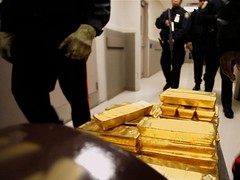 America’s Money Vault follows 55 million dollars worth of gold as it makes it’s way down into the most valuable gold vault in the world. Hidden deep under the streets of New York City, hundreds of billion dollars in gold bars—the wealth of nations—are tucked away in a bunker that is anchored to the bedrock of Manhattan Island itself.
America’s Money Vault follows 55 million dollars worth of gold as it makes it’s way down into the most valuable gold vault in the world. Hidden deep under the streets of New York City, hundreds of billion dollars in gold bars—the wealth of nations—are tucked away in a bunker that is anchored to the bedrock of Manhattan Island itself.
Next, we head above ground to a place where twenty four billion dollars changes hands every year, New York’s Gold District. Jake goes behind the storefronts to see how everybody from the street level to the brokers make their money buying, selling and even finding gold. He meets Onikwa Thomas who calls himself the urban miner and claims to earn up to four hundred dollars a week off of gold specks found in the cracks of sidewalks. And steps away thousands of dollars in transactions take place, made by Dimitriy Nezhinskiy as he wheels and deals in the world of gold hawkers.
America’s Money Vault then takes you to Washington, DC to hear from one of the most powerful men in the world of money, Federal Reserve Chairman Ben Bernanke. Chairman Bernanke gives us a window into the history of economic meltdowns.
Jake then heads to East Rutherford, New York where a vault that can reportedly hold $60 billion in cash sits in the middle of a suburban neighborhood. EROC is one of The Fed’s currency operations centers. Here rows and rows of cash and coin are counted, sorted, stacked, cleaned and shredded. EROC is equipped with special machines that are designed to detect counterfeit cash.
From the engraver’s studio to the production floor at the Bureau of Engraving and Printing, Jake goes deeper in the world of counterfeit deterrence and profiles the next generation $100 bill that’s not yet in circulation.
Finally, America’s Money Vault profiles the exclusive story of how the New York Federal Reserve Bank responded to the 9/11 crisis. Never-before publically-seen footage taken from the New York Fed’s security cameras help to tell the story of how the Fed’s actions prevented the terrorists from crippling the financial markets in the days and weeks that followed the collapse of the twin towers.
To read the complete article, see: Inside America’s Money Vault (tvblogs.nationalgeographic.com/2012/10/11/inside-americas-money-vault/)
To view the videos, see:
Inside America’s Money Vault Part One
(www.youtube.com/watch?v=LrzGcopSY9c)
Inside America’s Money Vault Part Two
(www.youtube.com/watch?v=kVxq9pE7RoE)
Inside America’s Money Vault Part Three
(www.youtube.com/watch?v=asYb8a0ckhQ)
DISCOVERY CHANNEL'S SILVER RUSH: THE GAIRSOPPA RECOVERY
Last week Dick Gaetano sent a note about the Discovery Channel program Silver Rush. I wasn't able to get it into last week's issue, but here it is belatedly.

This past summer, Discovery Channel cameras rolled as the world's best-known deep-sea recovery team, Odyssey Marine Exploration (OME), successfully recovered approximately 48 tons of silver bullion from the SS Gairsoppa - making it the deepest and heaviest cargo recovery in history. SILVER RUSH, a new three-part series narrated by Mike Rowe, tells the story of one of the greatest deep-sea treasure quests of all time. The series will take viewers on board Odyssey's flagship, the Odyssey Explorer, as it launches its most audacious operation ever -- locate and excavate three shipwrecks worth as much as a billion dollars all in one season. But will they be able to complete the entire recovery effort in just 90 days before punishing storms roll in?
I didn't see the show, but I asked Dick what he thought of it. He writes:
It was great. It mentions the WWI and WWII ships and the problems with equipment failure the first time they tried to lift off the deck. The cost of $100,000 a day to rent the ship sure was a factor. I think they will show it again .So sad they lost the Black Swan treasure to Spain. I hope they were paid for that recovery. They are doing a great job in their field.
To read the complete article, see: Silver Rush (dsc.discovery.com/tv-shows/silver-rush)
VATICAN RELEASES PLANS FOR 2013 SEDE VACANTE COINS
David Klinger writes:
Here is an article announcing that there will be SEDE VACANTE coins coming soon. The last such coin was issued in 2005, following the death of Pope John Paul II.
The Vatican will be issuing special-edition stamps and minting special coins marking the upcoming "sede vacante," the period when the see of Rome is vacant before the election of a new pope.
The stamps will be marked with the "sede vacante" symbol, which is a special striped umbrella extended over a pair of crossed keys, as well as be printed with the words, "Sede Vacante," "Citta del Vaticano" (Vatican City), and the year in Roman numerals.
They will be issued March 1 in four denominations of 70 and 85 eurocents, 2 and 2.50 euros.
Collectors will have to wait longer for the coins, however, which may be out as late as May, said an official at the Vatican's stamp and coin office.
A 2 euro coin and a silver 5 euro commemorative coin will be issued for sale, while a portion of the 2 euro coins will be put into general circulation.
The "sede vacante" coins will have the denomination on one side and the "sede vacante" symbol on the other.
The coin issue takes longer because Vatican coins are produced by the Italian mint and work is backlogged, the official said. Even the plaster mold of the designs still has to be made, he added.
The last of the Pope Benedict XVI coins, which bear the portrait of the pope, will be issued end of March.
To read the complete article, see: Vatican will soon issue special stamps, coins marking 'sede vacante' (www.catholicnews.com/data/stories/cns/1300849.htm)
THE BOOK BAZARRE
QUERY: INFORMATION ON FRANK LAPA'S RUSSIAN WIRE MONEY REPLICAS SOUGHT
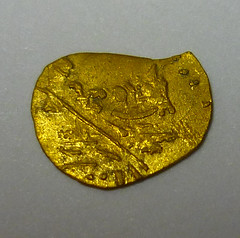
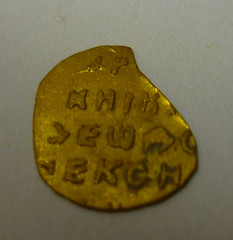
A few years ago I bought a gold Russian wire coin identified as being struck during the reign of Feodor Alexeevich (1676-1682) from a coin dealer in Kansas City, Missouri named Errol. My father and grandfather have known Errol for decades and consider him a friend and very trustworthy dealer. Errol told me that he bought the coin from a Russian coin collector in the 1970s, but did not know anything else about where it came from.
Since I bought the coin, I have done a great deal of research on wire coins, but I can't seem to find another example to compare it to. For instance, many silver examples I have found don't show this side of the coin. In hopes of solving this mystery once and for all, I recently brought the coin to a shop in St. Louis, Missouri (Scottsman's Coin) and they sent it to both PCGS and NGC, but neither organization could certify it as a fake or an original.
As such, I am not sure how I should proceed. The reason I am writing is that I found an E-Sylum article about Frank Lapa, author of a small pamphlet on wire coins, and I am wondering if anyone has any information about the wire coins he counterfeited. I have attached a scan of both sides of the coin. I look very forward to hearing from someone.
To read the earlier E-Sylum articles, see:
LAPA COUNTERFEITS
(coinbooks.org/esylum_v05n52a07.html)
FRANK LAPA
(coinbooks.org/esylum_v06n01a12.html)
BALDWIN'S TO OFFER THE DAVID FORE COLLECTION OF BRITISH INDIA
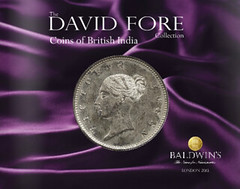 The David Fore Collection is the most impressive collection of Coins of British India ever to be sold at public auction. Comprising coins of British India, The Presidencies and Indian Native States, this collection will be sold in London in three parts, commencing 7th May 2013. The collection of over four thousand coins was formed over twenty five years by Dr. David Fore and Baldwin’s Canadian representative, Randy Weir. A plan to build a monumental collection took them on an amazing odyssey as the pair created a collection to rival the world famous collection of Fred Pridmore.
The David Fore Collection is the most impressive collection of Coins of British India ever to be sold at public auction. Comprising coins of British India, The Presidencies and Indian Native States, this collection will be sold in London in three parts, commencing 7th May 2013. The collection of over four thousand coins was formed over twenty five years by Dr. David Fore and Baldwin’s Canadian representative, Randy Weir. A plan to build a monumental collection took them on an amazing odyssey as the pair created a collection to rival the world famous collection of Fred Pridmore.
David began collecting coins as a child when he watched his father, who owned a small store in a rural town of two thousand people, search his change looking for the elusive US 1909 SVDB Penny. At age nine, David’s first job was delivering newspapers. Instead of buying comic books, he would take his weekly earnings of a few dollars to the bank and get rolls of pennies to search through, also looking for that 1909 Penny. His very first foreign coin purchase was an Indian Proof Restrike ¼-Anna. This coin was the beginning of a love affair with Indian coins that was to last for forty years. Randy was privileged to introduce David to the fascinating world of colonial coins some fifteen years later and David found the minor differences and array of patterns in the series so fascinating that Randy describes each purchase as being like prospecting for gold.
A symbiotic relationship between client and trusted specialist and a mutual fascination for Indian coinage inspired these two to create the collection that is being sold today. The focus for the collection was always to find the best quality coins and over four hundred of the coins contained in the collection originated from the Pridmore collection which was catalogued by A.H. Baldwin & Sons Ltd and sold by auction by Glendinings between September 1981 and October 1983, the Indian part being sold in October 1982 and October 1983, around the time the pair met. Other coins have similarly fine provenance, having been part of such celebrated collections as the Sir John Wheeler Collection, the Ken Wiggins Collection and The Diana Collection, all sold by Baldwin’s.
Randy Weir comments: “The last few years have seen many changes to the coin collecting hobby and, in particular, to the Indian coin market. Auctions have become more international and better communications have allowed more collectors direct access to auction houses, where the internet has revolutionised bidding. This has led to much more interest in the Indian series amongst others.”
“What good auction houses can offer collectors today is our knowledge of the coins being sold. We have an opportunity here with the Fore Collection to add to the knowledge from a few hundred years of experience here at Baldwin’s. We want to make our catalogues a source of information and a reference work that can be used, and will be useful, for years to come.”
All catalogues are available to view online at www.baldwin.co.uk
To read the earlier E-Sylum article, see: BOOK REVIEW: THE UNIFORM COINAGE OF INDIA 1835 – 1947 (www.coinbooks.org/esylum_v16n07a07.html)
DUTCH ARCHAEOLOGISTS FIND SHOE FULL OF MEDIEVAL COINS
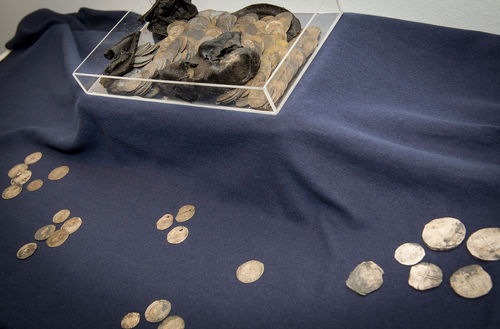
Archeologists in Rotterdam have found an old shoe stuffed with 477 silver coins during excavations behind the town hall.
Archaeologists say they have never before found a shoe filled with money, which ranges in dates from 1472 to 1592. On theory is that the owner of the shoe hid it under floorboards to protect it during the 80 Years War (1568-1648).
The value of the coins is put at 'many thousand euros'.
To read the complete article, see: Rotterdam archaeologists find old shoe stuffed with medieval money (www.dutchnews.nl/news/archives/2013/02/rotterdam_archaeologists_find.php)
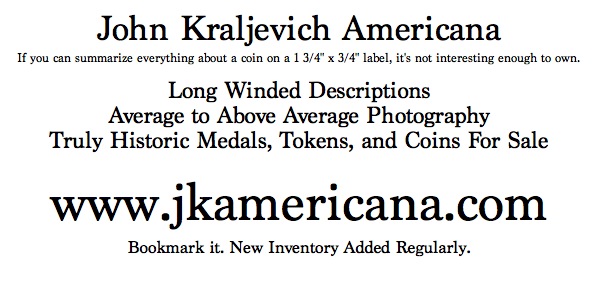
SOME NEW COIN DESIGNS: MARCH 3, 2013

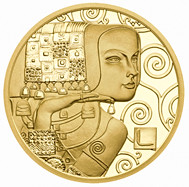
On February 27, 2013 the Austrian Mint has issued the second coin in its five gold coin series celebrating Gustav Klimt, a key painter of the art nouveau period whose art is easily recognized and admired around the world.
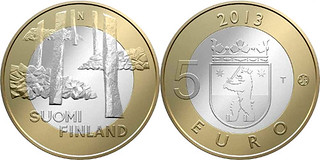
Sammallahdenmäki is a Bronze age burial site in Finland in Lappi municipality. It was designated by UNESCO as a World Heritage Site in 1999, and includes 36 granite burial cairns dating back more than 3,000 years. It is located on a hill in a remote area off the road between Tampere and Rauma. Originally, it was near the coast of the Gulf of Bothnia, but the land has risen so it is now 15 kilometers from the sea. It is one of the most important Bronze Age sites in Scandinavia.
AUSTRIA’S NEW KLIMT GOLD COIN
On February 27, 2013 the Austrian Mint has issued the second coin in its five gold coin series celebrating Gustav Klimt, a key painter of the art nouveau period whose art is easily recognized and admired around the world.
Klimt was born in Austria in 1862 and very early on his artistic gift became evident. He was classically trained, and began his career by painting murals and ceilings in large public buildings. His great love and primary subject, however, was the female form.
Klimt tended to work from his home, enjoying a relaxed lifestyle wearing robes and sandals, devoted to his art and life style. His life companion was Emilie Floege whom he met in 1890. Klimt’s love of the female form was not exclusive to his art but to the many relationships he enjoyed. He is known to have fathered 14 children. He died in 1918, at the age of 56, from a heart attack.
From about 1885 onward Klimt enjoyed his “Golden Period”, reflecting his critical success and acclaim, as well as his regular use of gold leaf in his paintings. His fame brought many patrons to him and he was able to be selective about the commissions he accepted. Klimt received the Golden Order of Merit from Emperor Francis Josef I in 1888, for the murals he painted in the Palace Theatre. Klimt’s painting entitled “Philosophy” won gold at the Paris Exhibitions of 1900, and “Death and Life” received first prize at the world exhibition in Rome in 1915. Several of Klimt’s paintings have brought some of the highest prices ever paid for art in the world.
 The obverse, featuring the “Tree of Life” from the Stoclet frieze, is framed by a square of the artist’s canvas, and was conceptualized by the mint’s chief engraver, Thomas Pesendorfer. The tree is made up of many fine swirls and mosaic-like pieces commonly found in the art of Klimt. To the right of the Tree of Life symbolizing The Eye of Horus, and interpreted by Klimt in the form of the falcon, a symbol of power of the Egyptian Pharos. Also on this side appears the country of issue, “Republik Oesterreich” or Republic of Austria, the face value of 50 euros, and the year of issue, 2013.
The obverse, featuring the “Tree of Life” from the Stoclet frieze, is framed by a square of the artist’s canvas, and was conceptualized by the mint’s chief engraver, Thomas Pesendorfer. The tree is made up of many fine swirls and mosaic-like pieces commonly found in the art of Klimt. To the right of the Tree of Life symbolizing The Eye of Horus, and interpreted by Klimt in the form of the falcon, a symbol of power of the Egyptian Pharos. Also on this side appears the country of issue, “Republik Oesterreich” or Republic of Austria, the face value of 50 euros, and the year of issue, 2013.
 The reverse features a portion of the frieze showing the head of a woman anxiously looking to the right, which is known as “Expectation.”
The reverse features a portion of the frieze showing the head of a woman anxiously looking to the right, which is known as “Expectation.”
The scarf on her head has a very intricate pattern of geometric square-like shapes. Her hand is held in a pose found commonly in Egyptian paintings. Her wrist has a beautifully intricate armband, while more jewels and geometric shapes and swirls can be seen in her clothing. The reverse of the coin was conceived and engraved by mint engraver Herbert Waehner.
To read the complete article, see: Austria’s new gold coin Klimt and His Women: “Expectation” (www.coinsweekly.com/en/News/4?&id=1828)
THE COIN WORTH LESS THAN ANY OTHER IN THE WORLD
 This month the Canadian mint stopped distributing the penny, or one-cent piece, as it costs more to make than it is worth. It's far from being the lowest-value coin around, however. Some central banks are clinging on to coins that are truly "small change".
This month the Canadian mint stopped distributing the penny, or one-cent piece, as it costs more to make than it is worth. It's far from being the lowest-value coin around, however. Some central banks are clinging on to coins that are truly "small change".
There are many precedents for scrapping small coins. The US abolished the half-cent in 1857 and the UK's halfpenny was withdrawn in 1984. New Zealand and Australia abandoned the one-cent and two-cent coin in the 1990s.
Now some campaigners in the US and UK want the penny to be scrapped, because nothing can be bought with a one-cent or one-penny coin.
But there are coins, still legal tender, that have even lower value.
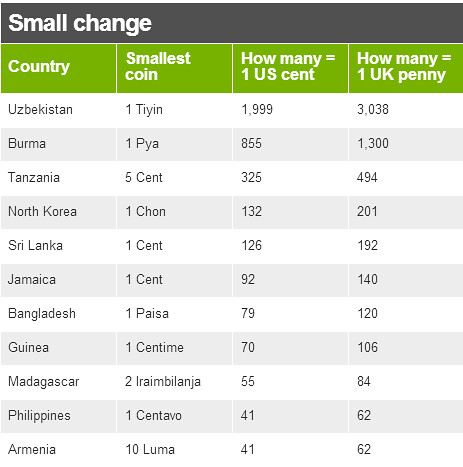
Take the Burmese Pya - the UK penny is worth 1,300 of them (the US cent is worth 850).
The lowest-value coin of all is the Tiyin from Uzbekistan. Some 3,038 equate to one UK penny (and 2,000 tot up to one US cent).
In practice, however, while these coins are legal tender, you would struggle to find them in everyday life.
"In Tanzania it's unlikely to find the five-cent coin in circulation because it literally cannot buy anything. The smallest you would probably find in the streets is 20 cents and you can buy a bunch of spinach in the local market for this," says Emanuel Boaz from the Tanzanian Central Bank.
To read the complete article, see: The coin worth less than any other in the world (www.bbc.co.uk/news/magazine-21572359)
Kavan Ratnatunga adds:
Talking of low denomination coins I wrote a piece on the difficulty of finding them in Sri Lanka: One Sri Lanka rupee is equivalent to 0.77 US cents. So the Sri Lanka 25 and 50 cent coins are only worth less than 0.2 and 0.4 US cent
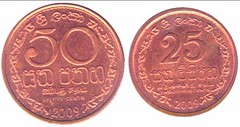
To read Kavan's article, see: The Sri Lanka 2009 25 cent and 50 cent coins (coins.lakdiva.org/srilanka/srilanka_2009_50c_25c.html)
To read a related E-Sylum article, see: A CHART OF THE VALUE OF THE U.S. CENT (www.coinbooks.org/esylum_v16n08a19.html)
ZIMBABWE MINTS GOLD COINS FOR DICTATOR MUGABE'S BIRTHDAY
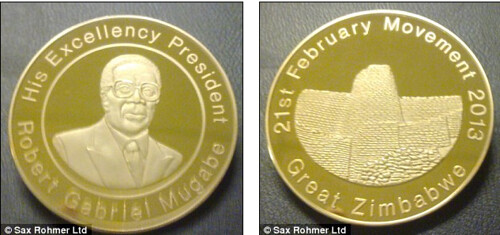
Zimbabwe is one of the poorest country's on Earth, but clearly despot Robert Mugabe doesn't seem to care on his 89th birthday.
The president celebrated it by immortalising himself in freshly minted gold coins and held a lavish party with a giant cake.
Guests, including his wife, first lady Grace, tucked into the four-tier treat made in his honour at the state house before he gave a thank-you speech.
To read the complete article, see:
A 22-carat dictator: Robert Mugabe has gold coins minted to celebrate his 89th birthday in poverty-stricken Zimbabwe
(www.dailymail.co.uk/news/article-2286993/A-22-carat-dictator
-Robert-Mugabe-gold-coins-minted-commemorate-89th-birthday.html)
MONEY ARTIST IGOR ARINICH'S BANKNOTE COLLAGES
Art is literally money for Belarusian artist Igor Arinich.
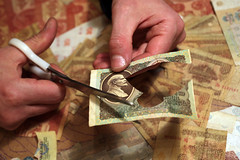 For several years, Arinich has used Soviet-era banknotes to create artistic images. One work he is particularly proud of is a replica of a painting by early 20th-century Russian artist Kuzma Petrov-Vodkin, which took half a year and about 3,000 banknotes to make.
For several years, Arinich has used Soviet-era banknotes to create artistic images. One work he is particularly proud of is a replica of a painting by early 20th-century Russian artist Kuzma Petrov-Vodkin, which took half a year and about 3,000 banknotes to make.
He uses a special glue to fix small pieces of notes, which he buys at local flea markets, to a sketch of a future image. Each work takes months to make.
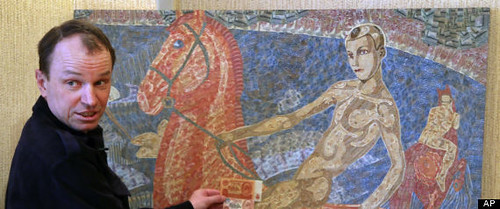
Arinich's works include portraits of Soviet founder Vladimir Lenin, Venezuelan President Hugo Chavez and Belarusian President Alexander Lukashenko. Arinich has been successful in selling them to customers in the 10-million ex-Soviet nation and neighboring Russia.
Arinich says he has sought to "transform people's view of money."
To read the complete article, see:
(www.huffingtonpost.com/2013/02/28/money-artist-igor-arinich
-belarus-money-art_n_2782951.html)
STOLEN BRONZE COIN OF AUGUSTUS RECOVERED IN SPAIN
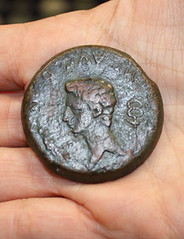 Spanish police have seized a "unique" ancient Roman coin that was stolen in a 600,000 euro ($786,000) haul in Madrid last year, they said Wednesday.
Spanish police have seized a "unique" ancient Roman coin that was stolen in a 600,000 euro ($786,000) haul in Madrid last year, they said Wednesday.
The brown bronze disc bearing the portrait of Augustus -- the Roman emperor who conquered parts of Spain -- was the most important of the 867 such coins seized.
"The collection is very important as much for its economic value as its historic, artistic and cultural importance," said Antonio Tenorio, chief inspector of the expert cultural heritage brigade that recovered the coins.
Police arrested a gold dealer in Madrid in connection with the case. Along with jewellery, the coins were stolen by burglars who broke into the home of a private collector in Madrid last April.
Tenorio said the Augustus coin was minted to commemorate victories against the northern Iberian Cantabrian and Asturian tribes.
"It is quite heavy and is one of the biggest ones ever seized. It seems to be a unique piece," Tenorio said. "There is not another one like it known in the world."
A police statement said the collector acquired the coin in 2002 at an auction house in New York for 30,000 euros.
Kerry writes:
Just based on the obverse photo, I can’t identify the coin without doing a lot more research, and even then, I might need the reverse photo for a positive identification. Roman provincial bronzes from Spain are not my area of expertise. The article says that the owner paid 30,000 Euros for the coin in a 2002 NYC auction. If this statement is accurate, then it is probably very rare. And since the market has exploded for high-end ancient coins since 2002, it is very possible that is worth substantially more than 30,000 Euros today.
To read the complete article, see: Spain police seize 'unique' stolen Roman coin minted in the first centuries BC and AD (artdaily.com/index.asp?int_sec=2&int_new=61029#.UTBVKDCNq5U)
FRANCIS CRICK'S 1962 GOLD NOBEL PRIZE MEDAL TO BE AUCTIONED
John Sallay writes:
Here's a story of possible interest to E-Sylum readers, about the auction of a gold Nobel Prize medal. There is also some other related material being auctioned with the medal. I’m not aware of another actual gold Nobel Prize medal entering the market, though there may have been and I missed it. This particular medal is particularly noteworthy given the recipient, of course.
I have a gilt bronze version of this same Nobel Prize Medal in Physiology or Medicine of the Nobel Assembly at the Karolinska Institute, issued to one of the 1977 winners, Roslyn Yallow. I understand that these gilt medals were made available to the winners for display purposes, so they did not have to have their actual gold medals out on display or otherwise just lying around. Even those are pretty scarce items.
The Nobel prize awarded to Francis Crick in 1962 for discovering the structure of DNA has been put up for auction by his family along with one of his lab coats, his books and other memorabilia.
It is believed to be the first Nobel prize placed at auction in more than 70 years and the opening bid is set for $250,000, Heritage Auctions said Monday.
Some of the proceeds from the April 10 auction in New York will help fund research at the new Francis Crick Institute in London set to be completed in 2015.
His family said Crick was a modest man who preferred to outfit his office with a big chalkboard and a portrait of Charles Darwin than to display his many awards.
The Nobel has been in storage for much of the past 50 years and his family hopes to sell it to a museum or institute where it can be on public display.
"Our hope is that, by having it available for display, it can be an inspiration to the next generation of scientists," said granddaughter Kindra Crick.
Born in England in 1918, Crick's graduate work was interrupted by the outbreak of World War II. He returned to research in 1949 with a position at Cambridge University.
A critical influence in his career was his friendship with the American zoologist and geneticist James Watson.
Together, they proposed the double-helical structure for DNA and the replication scheme in 1953. Crick and Watson subsequently suggested a general theory for the structure of small viruses.
Crick's children have fond memories of the ceremony in Stockholm where the King of Sweden gave him the award, along with Watson and Maurice Wilkins, who also contributed to the discovery.
To read the complete article, see: Nobel prize for discovering DNA up for auction (artdaily.com/index.asp?int_sec=2&int_new=60987#.UTK6tTCNq5U)
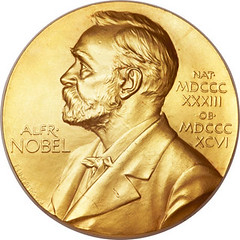
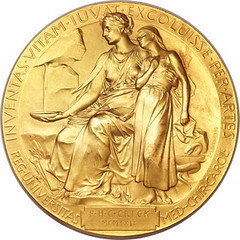
To view the images and (future) lot description, see: http://historical.ha.com/c/item.zx?saleNo=6093&lotIdNo=50001
AGOSTINO RAMELLI'S 1588 LIBRARY BOOK WHEEL
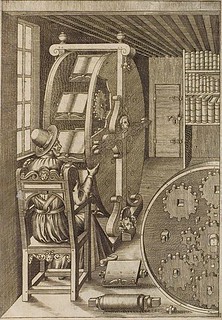 One of the defining features of Kindles and iPads and their fellow e-readers is their ability to store tons of books in the same place, at the same time. Which means that, thanks to these quintessentially twenty-first-century technologies, we are newly encouraged to consume our books not as long meals, but as occasional snacks: a few nibbles of Moby-Dick here, a few bites of Bossypants there. Under e-readers' influence, the linear project of book-reading -- from page 1 to page 501, sequentially -- has shifted to something much more chaotic, much more casual, much more accommodating to whimsy and whim.
One of the defining features of Kindles and iPads and their fellow e-readers is their ability to store tons of books in the same place, at the same time. Which means that, thanks to these quintessentially twenty-first-century technologies, we are newly encouraged to consume our books not as long meals, but as occasional snacks: a few nibbles of Moby-Dick here, a few bites of Bossypants there. Under e-readers' influence, the linear project of book-reading -- from page 1 to page 501, sequentially -- has shifted to something much more chaotic, much more casual, much more accommodating to whimsy and whim.
Literary restlessness, though, dates back much further than the 21st century. It dates back, at least, to the 16th -- to the Italian engineer Agostino Ramelli, and to his desire for a reading interface that would allow for book-borne snacking. Ramelli, who spent his professional career creating siege machinery for the military, wanted to develop a device that would allow a reader to reference multiple books at (pretty much) the same time -- a desire made especially practical given how large and heavy books were back then.
In his own book, published in 1588 and modestly titled The Various and Ingenious Machines of Captain Agostino Ramelli, the designer outlined his vision for a wheel-o-books that would employ the logic of other types of wheel (water, Ferris, "Price is Right", etc.) to rotate books clockwork-style before a stationary user. Ramelli planned to use epicyclic gearing -- a system that had at that point been used only in astronomical clocks -- to ensure that the shelves bearing the wheel's books (more than a dozen of them) would remain at the same angle no matter the wheel's position. The seated reader could then employ either hand or foot controls to move the desired book pretty much into her (or, much more likely, his) lap.
To read the complete article, see:
Behold, the Kindle of the 16th Century
(www.theatlantic.com/technology/archive/2013/02/behold-the-kindle
-of-the-16th-century/273577/#.US8TN66kPb8.google_plusone_share)
FEATURED WEB PAGE: HISTORY OF KOREAN COINS
This week's Featured Web Page is on the history of Korean coins.Korea did not begin to use money until the Koryo Period (Goryeo 高 麗) (936-1392 AD) when coins from China's Song Dynasty (宋朝) (960-1279 AD) were imported and began to circulate. Prior to this time, barter based on rice and cloth was the principal means of exchange.
The first coins actually minted in Korea occurred during the 15th year (996 AD) of the reign of King Songjong (成宗). This coin was cast in both bronze and iron and was based on the standard Chinese cash coin which was round with a square hole in the center.
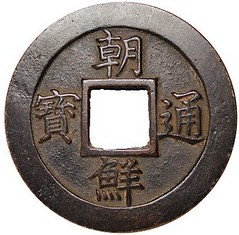
primaltrek.com/koreancoins.html
Back to top